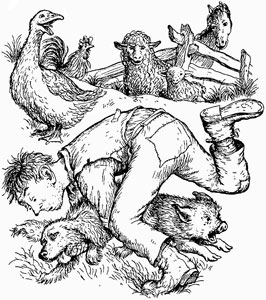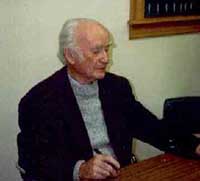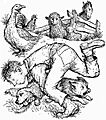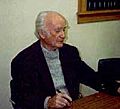Garth Williams facts for kids
Quick facts for kids
Garth Williams
|
|
|---|---|

An illustration from Charlotte's Web showing Williams' energetic line, his penchant for detail, emotion and action, as well as his use of texture and shading.
|
|
| Born | April 16, 1912 New York, New York
|
| Died | May 8, 1996 Marfil near Guanajuato, Mexico
|
| Education | Westminster School of Art, Royal College of Art, British School at Rome |
| Known for | Illustrating children's books |
|
Notable work
|
Illustrations for Charlotte's Web and Stuart Little by E.B. White; Illustrations for The Cricket in Times Square by George Selden; illustrations for the Little House series by Laura Ingalls Wilder |
| Style | Line drawing |
| Awards | British Prix de Rome |
Garth Montgomery Williams (born April 16, 1912 – died May 8, 1996) was a famous American artist. He became well-known after World War II for illustrating children's books. Many of the books he drew pictures for are now considered classic stories for kids.
His drawings are so special that they are often thought of as part of the stories themselves. For example, it's hard to imagine Stuart Little, Charlotte's Web, or the Little House series by Laura Ingalls Wilder without his art. His friendly, fuzzy baby animals also appeared in many Little Golden Books.
Garth Williams believed that books given to or read to children could have a big impact. He said he used his illustrations to "awaken something of importance" like humor, responsibility, respect for others, and interest in the world.
Contents
Early Life and Art School
Garth Williams was born in New York City in 1912. His father was a cartoonist for Punch magazine, and his mother was a landscape painter. He once said, "Everybody in my home was always either painting or drawing."
He grew up on farms in New Jersey and Canada. In 1922, his family moved to the United Kingdom, where his parents were from. Garth first studied architecture and worked as an architect's helper. But when the Great Depression hit, he decided to become an artist instead.
He started studying art at the Westminster School of Art in 1929. In 1931, he won a four-year scholarship to the Royal College of Art. There, he created a sculpture that won the British Prix de Rome, a special art award. He continued his studies in Germany and Italy until World War II began in Europe.
During the war, Garth volunteered with the British Red Cross in London. He helped people who were hurt or killed by bombs. After a close call with a bomb blast, he sent his wife and daughter to Canada. He joined them in New York in 1942.
Becoming a Famous Illustrator
In the United States, Garth Williams worked in a war factory making lenses. He also drew posters for the war effort. He tried to get work at big publishing companies.
In 1945, he got his first job as an illustrator from editor Ursula Nordstrom at Harper's Department of Books for Boys and Girls. The story goes that Ursula was waiting for a new book manuscript. When it arrived, the author had a note attached that said, "Try Garth Williams." The author was E. B. White, and the book was Stuart Little.
The book became a huge success with both kids and adults. Garth Williams later said that seeing grown-ups reading Stuart Little on buses made him want to keep illustrating books.
Soon after, he worked with Margaret Wise Brown on The Little Fur Family. This book was very popular. One mother even wrote to say her son tried to feed his supper to the book! Garth Williams illustrated eleven of Margaret Wise Brown's books in total.
In 1951, he illustrated Charlotte's Web (published in 1952). His oldest daughter, Fiona, who was a toddler during the war, was his model for the character Fern Arable.
Later in his life, Garth Williams lived mostly in Marfil, a small town in Mexico. He was part of a group of people who rebuilt homes in old silver mine ruins. At 81 years old, he estimated he had illustrated 97 books!
Garth Williams passed away at his home in Marfil at age 84. He was buried in Aspen, Colorado.
Little House Books (1953)
Garth Williams was asked to illustrate the new editions of the Little House books around 1947. To understand the world of Laura Ingalls Wilder's childhood, Garth traveled across the Midwestern United States. He had never been west of the Hudson River before!
He visited the places where the Ingalls family lived 70 years earlier. He took photos and sketched landscapes, trees, birds, wildlife, buildings, and towns. He even searched for the spot where the family built their dugout home by Plum Creek.
He said, "I did not expect to find the house, but I felt certain that it would have left an indentation in the bank." He found a hollow in the bank that matched Mrs. Wilder's description perfectly. He wanted to draw the house as Laura would have seen it: a happy, flower-filled refuge with the sound of the stream nearby. And that's how he drew it!
Originally, the plan was for Garth to create eight oil paintings for each book, making 64 paintings in total. But this was too expensive. So, Garth Williams illustrated the Little House books using simple pencil, charcoal, and ink. He did much of this work in Italy.
He also illustrated the first edition of The First Four Years (1971). This book is usually considered the last of the nine books in the Little House series.
How He Drew His Pictures
In an interview in 1980, Garth Williams explained how he illustrated stories by other writers. When he first read a story, he would often get ideas for 30 or 40 pictures.
He said, "To compose the pictures is very hard... I look for all the action in the story; then I arrange forms and color." He always tried to imagine what the author was seeing. He had to choose only a few drawings, sometimes as few as ten per book. He would make a list of his ideas, noting the page number in the manuscript.
Garth Williams rarely drew straight lines. For the Little House books, he used charcoal and graphite pencils. The first book, Little House in the Big Woods, feels warm and cozy, almost like a small animal's home.
He used pen and ink for books like The Cricket in Times Square, Charlotte's Web, and Stuart Little. For The Giant Golden Book of Elves and Fairies (1951), he used a lot of colored pencil. In the Golden Books, he often used oil pastels, ink washes, and watercolor. His book The Rabbits' Wedding (1958) showed how well he could draw textures like hair, hide, grass, and fur using just a few soft colors.
Books He Wrote and Illustrated
- (1946). The Chicken Book: A Traditional Rhyme.
- (1951). Adventures of Benjamin Pink.
- (1952). Baby Animals.
- (1953). Baby Farm Animals.
- (1954). The Golden Animal ABC.
- (1955). Baby's First Book.
- (1958). The Rabbits' Wedding.
- (1986). Self-Portrait.
Books He Illustrated for Other Writers
Garth Williams illustrated many beloved books for other authors, including:
- Margaret Wise Brown (e.g., Little Fur Family, Mister Dog)
- Natalie Savage Carlson (e.g., The Family Under the Bridge)
- Russell Hoban (Bedtime for Frances)
- Randall Jarrell (The Gingerbread Rabbit)
- Dorothy Kunhardt (many "Tiny Nonsense Stories")
- Jennie D Lindquist (e.g., The Golden Name Day)
- Else Holmelund Minarik (The Little Giant Girl and the Elf Boy)
- Lilian Moore (My First Counting Book)
- Miriam Norton (The Kitten Who Thought He Was a Mouse)
- Jack Prelutsky (e.g., Ride a Purple Pelican)
- George Selden (e.g., The Cricket in Times Square series)
- Margery Sharp (The Rescuers series)
- Mary Stoltz (e.g., Emmet's Pig)
- E. B. White (Stuart Little, Charlotte's Web)
- Laura Ingalls Wilder (the first eight Little House books, and The First Four Years)
- Charlotte Zolotow (e.g., Over and Over)
Images for kids
-
An illustration from Charlotte's Web showing Williams' energetic line, his penchant for detail, emotion and action, as well as his use of texture and shading.




